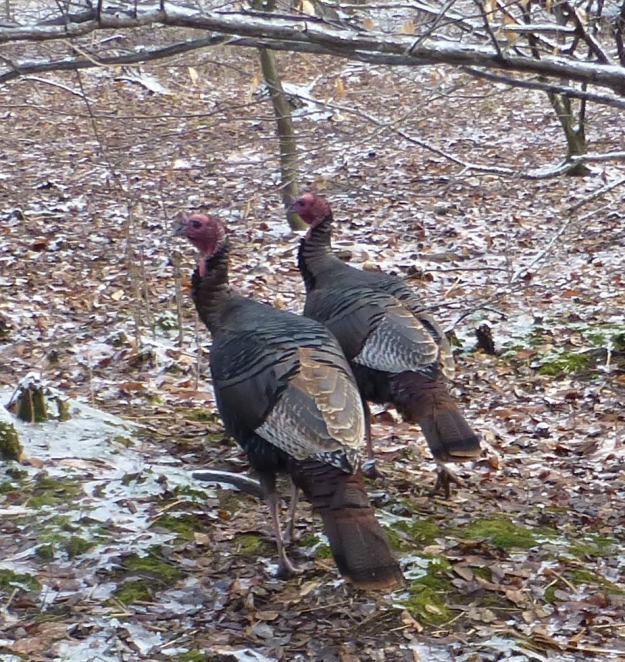- When Europeans first arrived in the New World, there were millions of Wild Turkeys ranging from Canada to Mexico.
2. Due to habitat loss and extensive hunting, this figure was reduced to about 30,000 by 1940.
3. The last native Wild Turkey in Ontario was recorded in 1902.
4. A male turkey has a wingspan of about 64 inches and weighs about 16 pounds.
5. Compare this to a male Trumpeter Swan which has wingspan of about 80 inches and weighs about 13.7 pounds or a male Canada Goose which has a wingspan of about 60 inches and weighs about 9.8 pounds.
6. The best place to see Wild Turkeys in the Toronto area is at Lynde Shores near Whitby. On Boxing Day, 2018 there were more than a dozen present and they are relatively tame.
7. They occasionally show up in High Park as in these photos:
8. Reintroduction of Wild Turkeys in Ontario began in earnest in the 1980’s. In 1984, Ontario received 284 Wild Turkeys from various U.S. states in exchange for river otters, partridge, geese and moose.
9. Wild Turkeys are now plentiful in Muskoka and have been seen as far north as Nipissing.
10. Turkeys in northeastern North America use mature oak-hickory forests and humid forests of red oak, beech, cherry and white ash. The forest at Lynde Shores is one of the latter.
11. Wild Turkeys forage in groups for plant matter, mostly on the ground, but sometimes climbing into shrubs or low trees for fruit.
12. In fall, winter and early spring, they scratch the forest floor for acorns, beech nuts, hickory nuts, wild black cherries, white ash seeds and other seeds and berries.
13. When deep snow covers the ground, they eat hemlock buds, evergreen ferns, Sensitive Fern fronds, club mosses and burdock.
14. In late spring and summer, Wild Turkeys strip seeds from sedges and grasses and will eat salamanders, snails, beetles and other insects.
15. Wild Turkeys nest on the ground in dead leaves, in thick shrubbery or even in open hayfields.
16. There are 4 -17 eggs which are incubated for 25 – 30 days.
17. Wild Turkeys get around mostly by walking but are also able to run and fly.
 18. At sundown, turkeys fly into the lower branches of trees and gradually move higher to a good roosting spot.
18. At sundown, turkeys fly into the lower branches of trees and gradually move higher to a good roosting spot.
19. Courting males gobble in order to attract females and to discourage competing males.
20. They display for females by strutting with their tails fanned and wings lowered while making various non-vocal sounds.
21. Males breed with multiple females and leave the chick-rearing to them.
22. They form all-male flocks outside of the breeding season.
23. Turkeys are the second most popular game species in the U.S. after deer.
24. Males have a “beard” of feathers on the breast.
25. These birds really are named after the nation of Turkey. Early Europeans saw turkeys and they were reminded of guinea fowls which are often seen in Turkey.
Miles Hearn



























Is this a coincidence or are you aware that a Wild Turkey has been present near Christie Pits (Art Eggleton Park) since the Fall of 2018? It was observed and counted during the Toronto Christmas Bird Count of 2018. It is being fed apparently by neighbours and has been named “Rose”. There was a news story interview on CBC Radio on Jan. 3, 2019 about “Rose”. I have seen the bird and it has a “beard” and apparently only 10% of females have a “beard” so I am not sure of its gender.